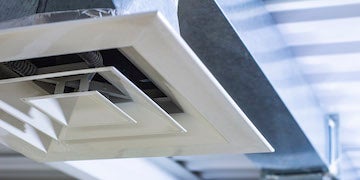In March 2020, the Harvard Healthy Buildings Program completed data collection for the Global CogFx study, an international, one-year study of indoor environmental quality and office worker health and productivity. This week, the first of several papers analyzing data from the Global CogFx study was published. This first paper evaluated how building operations impacted indoor fine particulate matter (PM2.5) concentrations in the office buildings that participated in the study. It is important to study ways to reduce exposures to PM2.5 because this air pollutant has negative effects on cognitive function and cardiovascular, respiratory, and neurological health.
Three important findings from this paper are described below.
- Indoor PM2.5 was generally lower than outdoor PM2.5 at office buildings in China, India, the United Kingdom, and the United States, but indoor PM2.5 did sometimes exceed the World Health Organization’s health-based exposure guidelines in China and India. This finding suggests that buildings can be protective against PM2.5 exposure, but that additional protections to reduce indoor PM2.5 levels may be needed in places with high outdoor PM2.5 concentrations.
- Operating ventilation systems with filters during work hours can protect against intrusion of outdoor PM2.5. During work hours, when ventilation systems are typically operating normally, indoor PM2.5 increased less for a given increase of outdoor PM2.5 than during non-work hours, when ventilation systems may be set back or operating at a lower capacity than normal. This finding suggests that even when outdoor PM2.5 is high due to local industrial pollution or a wildfire, operating the ventilation system (with a filter correctly installed) will result in better indoor air quality than turning the system off.
- Indoor PM2.5 was lower in buildings with higher efficiency filters. Compared to buildings with MERV 7-12 filters, indoor PM2.5was on average 39.4% lower in buildings with MERV 15+ filters and 30.9% lower in buildings with MERV 13–14 filters, controlling for relevant variables. This finding suggests that indoor PM2.5 can be substantially reduced by the use of high efficiency filters.
The full paper can be found here.
“The effects of ventilation and filtration on indoor PM2.5 in office buildings in four countries,” Emily R. Jones, Jose Guillermo Cedeño Laurent, Anna S. Young, Piers MacNaughton, Brent A. Coull, John D. Spengler, Joseph G. Allen, Building and Environment, August 2021. DOI: 10.1016/j.buildenv.2021.107975





